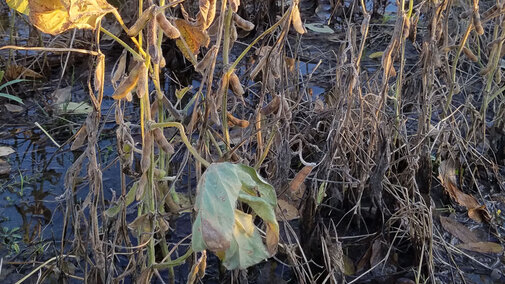Crop insurance is typically thought of as protecting against low yields and/or revenue. However, crop insurance also provides some protection against low quality. This fall’s weather could trigger indemnity payments due to low quality.
The following discussion describes how crop insurance adjusts soybean yield due to quality for a particular county. While I have not found any differences in discount factors among counties, it is possible. The final outcome depends upon what the county actuarial documents stipulate. Discount rules contain quite a few if/then statements, so final outcomes will depend upon the particular production characteristics.
Crop insurance adjusts harvest yield based on quality discounts using predetermined factors. The factor represents how the discount impacts yield. With soybeans four types of discounts plus the other category are considered. The four discount types are: grade, test weight, damage, and sample grade. The other category, formally called “deficiency not in discount factor charts,” determines the final discount when quality discounts fall below, say a very low test weight that is not outlined in the quality discounts.
Final yield is determined by multiplying the harvest yield by one minus the sum of all discount factors.
Factors for each discount type are summarized as follows:
- A sample grade outcome results in a 3% discount factor so no discount factors for any other grade.
- For test weight, discount factors start at 48 to 48.99 lb with a discount factor of 0.7% that increases to a 1.5% discount factor with a 44 to 44.99 test weight. Test weights lower than 44 are settled through the other category.
- Damage discounts start at 8.01% with a 4.4% discount factor that increase to a 25.2% discount factor with a 34.01% to 35% damage. Just like with test weight, damage over 35% are settled through the other category. Damage includes everything except heat.
- Odor sample grade discounts are 2% for musty odor, 2% for sour odor, and 4% for commercially objectionable foreign odor (COFO).
Suppose your harvest soybean sample comes back as sample grade, 48.5 pound test weight and 9.4% damage and you have a harvested yield of 50 bushels per acre. Yield would be reduced by 8.9% from the summation of 3% (sample grade) + .7% (test weight discount) + 5.2% (damage discount). Final yield would equal 45.55 (50*(1-.03-.007-.052)) bushels per acre.
Producers with multiple insurable units, likely coming from optional or basic units, should contact their insurance agent to determine the process for keeping samples of each unit. This is very important when soybeans are going to the bin.
Quality discounts found here will likely not cover the entire price deduction found at the elevator. While this is unfortunate, some coverage is better than none. It is possible to get discount factors updated and/or modified for upcoming insurance contracts.
For questions and comments please contact Cory Walters at cwalters7@unl.edu

